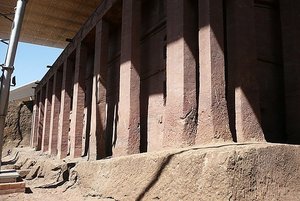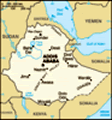Advertisement
Published: June 16th 2017

 Lalibela
Lalibela
The famous rock hewn churches! The churches in Lalibela are not 'built into the rock' as they are in other areas of Ethiopia, they are entirely freed from it!
In what is referred to as the Northwest group, there are 11 churches connected by tunnels and narrow alleyways carved out of the rock.Geo: 12.0743, 38.8785
NOTE: Carole has updated this with more details about our time in Lalibela - plus photos!
We came to Lalibela yesterday via Ethiopia Airlines. Interesting story to come on that experience.
Richard had purchased the tickets online before we left the US and sometime after that his credit card was used fraudulently so the card was cancelled. We get to check in at the airport and the ticket agent asked to see the credit card. Hmmm, this was obviously going to be a problem because Richard cut it up. After lengthy discussion trying to explain what happened (by the way, the charge had been processed and Richard had already paid the bill) we ended up having to buy tickets all over again. It is important to note that this is not just an Ethiopian Airlines policy. All airlines reserve the right to ask to see the credit card - so be aware! I was once flying in the US and a woman was flying on a ticket her husband had purchased with his credit card, which she, of course did not have and the same thing happened to her.
Lalibela is very interesting and we have hired a local guide - Gashaw

 Lalibela
Lalibela
The metal struts hold up a roof that protects this particular church. It was built by UNESCO - Lalibela is a World Heritage site - and done quite nicely as it doesn't really interfer with seeing the detail of the architecture. Importantly it protects the church from seepage through ancient cracks during the rainy season. who we met at the Lalibela airport. He is very knowledgeable about the history here and there is a lot of it!
Our first day here we visited the famous rock hewn churches. The cost to enter is now Birr300 which is double what the guide books say - inflation has hit Ethiopia very hard. In spite of this, it is well worth seeing and I do recommend going with one of the licensed guides. The ticket is good for several days so you can go back as many times as you like. The churches are mostly right in the town of Lalibela and located in two main areas - the Northwestern group which has six churches and the Southeastern group which has 5, one of which is actually a bit further away from the group, Bet Giyorgis which is likely the most famous of them all because of the cross carved into the roof which is easily seen as you approach it from 'ground level'. These churches are amazing because they are not carved into the rock they are freed entirely from it - check out the photos.
Today (day 2) we visited a church built inside a cave located
about 30 km from Lalibela. The drive out of Lalibela gave us the perfect introduction to life in Ethiopia. It is Saturday and market day in Lalibela and many of the villages in the area. The road was filled with people and animals heading to the market. These people walk everywhere and between the people (mostly women and children) carrying loads on their backs or heads, there are donkeys carrying all kinds of things plus a variety of livestock. It was amazing as we were the only vehicle on the road and it was a constant stream of people and animals. Along the way we stopped to look at a giant fig tree!
The church is in a lovely location, high on a hill with a long 'paved' path leading up to it. This church is not often visited by tourists but we had read about it and wanted to see it. It is very different from the rock hewn churches in Lalibela in that it is built from alternating layers of wood and stone rather than excavated - and it is inside a huge cave! This is Yemrehanna Kristos and because the cave provides such good protection it is very
well preserved. the church also predates the rock hewn churches by about 80 years. The priest there is young and very friendly. He knew Gashaw very well so he spent a lot of time with us showing us the inside of the church and demonstrating how the wonderful drums are used during services. There is also a large area in the back of the cave that houses the skeletons of people who have been 'laid to rest' there - hundreds of years ago! These are supposedly pilgrims who'd come to die here over the centuries! Kind of like Hindus going to the Ganges, I guess.
On the way back we stopped at a local market in Balibela a smaller town along the way. The market was really fascinating - nothing like you might think of even if you have visited markets in other countries. This was all agricultural with people from as far a 40 km away coming to buy or sell everything from vegetables to goats and cattle and recycled shoes! The people were very tolerant of the ferangi's visiting. Most were too busy getting their purchasing done but the children were curious and we had a small 'herd' of
them follow us around. Most just looking at us and curious to see what we were taking photos of but one or two wanted to talk and we love that so we chatted with a couple of young boys. They are so curious and spoke English quite well.
Advertisement
Tot: 0.061s; Tpl: 0.024s; cc: 8; qc: 24; dbt: 0.0251s; 1; m:domysql w:travelblog (10.17.0.13); sld: 1;
; mem: 1.1mb

























Tric Syz
non-member comment
The church in the cave fascinated me. Did anyone say why they did that....protection from enemies, or maybe from the sun, or sand...hmmm? Is a ferangi like a gringo?